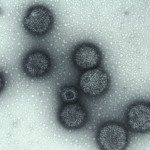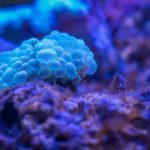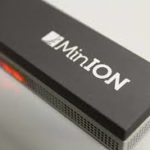Laurent Dacheux obtained his doctorate in Pharmaceutical Sciences (PharmD) in 2000 at the University of Sciences and Techniques of Tours, France, after defending his thesis on anticancer immunotherapy and pharmacogenetics. More precisely, he had the opportunity to participate to one of the princeps studies demonstrating the importance of pharmacogenetics in the prediction of treatments based on monoclonal antibodies, in the team of Pr. Hervé Watier at the Faculty of Medicine of Tours and the University Hospital Center of Tours. This study focused on the influence of the FCGR3A-158 polymorphism on the response to treatment with rituximab (MabThera®) in patients with follicular-type non-Hodgkin’s lymphoma.
He was graduated in 2005 from a Doctorate in Science (PhD) of the University of Sciences and Techniques of Tours, France, still in the field of monoclonal antibodies but applied to infectious diseases, and more specifically to virology. He carried out a study on the analysis of the kinetics of exposure of major neutralization epitopes on the surface of the envelope glycoproteins of HIV-1 during natural infection, using three major monoclonal antibodies (IgG1b12, 2G12 and 2F5). One of the main results of this study, carried out in Pr. Francis Barin’s team at the Faculty of Medicine of Tours, was the confirmation of the existence of an evolving glycan shield on the envelope of HIV during infection, which modules the exposure of neutralization epitopes.
Since 2004, Laurent Dacheux is acting as one of the deputy directors of the National Reference Center for Rabies (NRC-R) at Institut Pasteur, Paris. Among the several missions dedicated to this center and provided by the French Ministry of Health (through the national public health agency Santé publique France), one of his main activities is to supervise the activities of diagnosis of rabies in humans (nearly 10-15 suspicions/year) and for animals suspected of rabies transmission to humans (around 1,300 samples/year), both in a high-level quality assurance environment (accreditations ISO 15189 and ISO/IEC 17025, respectively). In addition, he is in charge of the supervision of the serological survey of vaccinated patients (around 100 samples/year). He participates in advisory and expert activities with health professionals (veterinarians, physicians) or public health and veterinary government institutions. In the NRC-R, he is more specifically invested in the development, the validation and the diffusion of the diagnostic techniques related to rabies. One of his topics in this field is focused on the improvement of the diagnosis of human and animal rabies in the endemic areas through the development of innovative, rapid and applicable tests in field conditions, through for example the Field Tests for Rabies Diagnostic (FiTeRaD) project.
In parallel, Laurent Dacheux is also involved in the WHO Collaborative Centre for Research and Reference on Rabies (WHO-CC Rabies), in which he is in charge of various activities focused on the diagnosis, especially those regarding training activities through lectures and organization of workshops in Asia and Africa. In the framework of the WHOCC-Rabies and based on his expertise, he participates to the updating of international reference books and manuals (WHO, OIE, etc.) on rabies diagnosis.
Lastly, he is also a permanent research engineer in the Lyssavirus, Epidemiology and Neuropathology unit (which housed both the NRC-R and the WHO-CC Rabies). In this unit, he is leading integrated researches focused on the two main animal reservoirs of rabies, with carnivores (mainly dogs) and bats, in an One Health approach, which are summarized below.
Integrated study of the lyssavirus / rhabdovirus and bat model: exploration of viral diversity, understanding of viral diffusion mechanisms at the colony level and viral infection mechanisms at the cellular level
It is now established that bats represent the original and the main reservoir of lyssaviruses, in which almost all (16 of 18) of the recognized viral species have been found. Broadly speaking, these animals also harbour many other viral zoonotic agents, including various rhabdoviruses, making them a major source of viral emergence. However, the diversity of these viral populations, and more particularly of lyssaviruses and of other rhabdoviruses (even at the level of the complete virome) remains largely incomplete. Similarly, the dynamics of circulation of these viruses within bat colonies is still unknown, as well as the mechanisms of viral infection at the cellular level or the risk of transmission to humans. However, this data is essential to assess the risk of emergence in humans and to try to put in place potential prevention measures.
The objectives of this integrated research axis are therefore to: 1 / research and characterize (new) lyssaviruses or rhabdoviruses present in targeted bat colonies in different geographic regions and 2 / study the mechanisms supporting their circulation within these colonies. In addition, 3 / a metagenomic approach associated with a dedicated bioinformatics workflow are implemented on a selected panel of bats, in order to widen the study to the scale of the complete virome. Finally, 4 / an analysis of the mechanisms of infection at the cellular level is in progress, using some prototype lyssaviruses.
Precise and large-scale deciphering of the dynamics of canine rabies spread in West and Central Africa: a key step in the eradication of human rabies
Dog constitutes one of the major reservoirs of the rabies virus (RABV), and the main vector of rabies in humans (nearly 60,000 deaths per year worldwide), in particular in the endemic areas in Asia and Africa. Effective measures to control and eradicate this zoonosis are well known, and are mainly based on the post-exposure prophylaxis for exposed patients, the control of canine populations, the mass vaccination of dogs against rabies and the awareness of the population and the mobilisation of the stakeholders. However, in order to set up these measures effectively in the endemic areas, one of the first elements relies on precise understanding of the dynamics of the infection in its reservoir, which varies among the geographic, epidemiological or environmental context. To date, studies incorporating all of these parameters on a large scale are still limited, particularly in the African context. Similarly, no study has yet exhaustively described the circulation of the virus at different scales of observation (urban, peri-urban, national and international / inter-regional) in the same country, in particular in the context of canine vaccination campaigns.
In order to try to answer these questions, this second research axis focused on several collaborative research programs in central and West Africa. This first one is based on a recent study leaded by the Swiss Tropical and Public Health Institute on a rabies surveillance program and mass vaccination campaigns of dogs in N’Djaména, Chad. During this study, two dog vaccination campaigns were able to stop the transmission of rabies in both dog and humans for several months. However, the resurgence of rabies appeared more quickly than expected by the mathematical models used at the end of these campaigns. Preliminary phylogenetic analysis conducted on the RABV virus strains suggested the existence of a reintroduction via exposed animals from adjacent rural areas. Further investigations on this potential phenomenon of reintroduction and circulation between rural and urban areas are ongoing, at the peri-urban scale but also at the national and inter-regional level, in order to obtain a model of dissemination and control that can be transposed to other African countries. In the meantime, this approach is extended in West Africa, particularly in Mali, Côte d’Ivoire and Liberia, and in Central Africa with the Democratic Republic of Congo.
Ultimately, all of these results will represent essential elements for the implementation of the next rabies control plans in Chad, but also in the other neighbouring countries, including the Central African Republic with the second research project ERVB (rabies elimination in the city of Bangui), conducted in collaboration with Institut Pasteur de Bangui in Central African Republic, which aims is to eliminate rabies in Bangui using a “One Health” approach.
The global and final aim of these activities is to provide some clues and recommendations to implement and to fit the best surveillance and control program for rabies, in order to reach the eradication of human rabies due to dog by 2030 as proposed by WHO-OIE-FAO.










